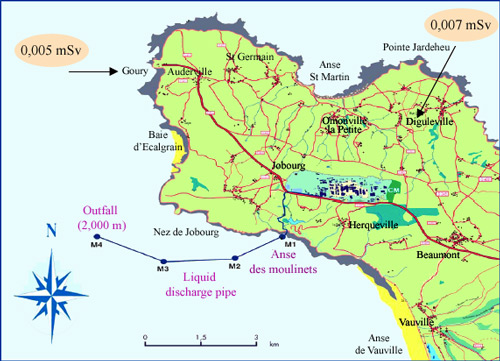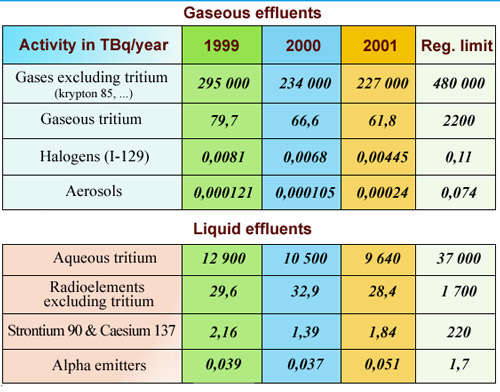Low and well-controlled environmental releases

Releases into the sea from La Hague plant
Liquid effluent from La Hague is released into the sea via a pipe extending from Anse des Moulinets, 60 m from the coast (M1) to an outfall 5,000 m off the coast of Nez de Jobourg (M4). Strong marine currents help to disperse the releases, which primarily consist of tritium.
© AREVA
A small portion of the radioactive waste from nuclear power plants is encountered in liquid or gaseous form during reprocessing operations. During such operations, multiple barriers are put in place to prevent radioactive atoms from migrating to the biosphere.
Despite the precautions taken, these barriers are never totally tight, and small quantities of low- and intermediate-level effluents are released into the sea or the atmosphere. Unlike solid waste, which is conditioned, concentrated and immobilised, these types of waste are rendered less harmful by greatly diluting them.
Are the existing precautions adequate? Effluent from La Hague hit the headlines in 1999. The environmental organisation Greenpeace installed an underwater camera to film the waste discharge pipe and sent a balloon to measure radioactivity exiting the plant’s stack.

Activities for gaseous and liquid releases
Gaseous and liquid activity (annual releases) observed at La Hague in 1999, 2000 and 2001. The activity levels, stated in TBq (terabecquerels), are compared with the maximum permitted annual releases (NB: results have improved since). Note that the principal releases in terms of activity (krypton 85 and tritium) are not highly toxic. The other releases were far below the authorised limits.
© IN2P3 (source AREVA/ S. Lebar, P. Devin)
The plant in La Hague reprocesses nearly 1,000 tonnes of spent fuel from numerous European power plants each year. In 2000, it released 29 grams of tritium, a highly active element due to its short half-life of 12.34 years. These few grams, which generate 10 millions billion disintegrations per second (becquerels or Bq), are released into the sea through the plant’s outfall pipe in the form of tritiated water.
Although the becquerel is an extremely devalued unit, such activity figures appear quite impressive. But they are not the appropriate criterion. For the cells in our bodies, it is the radiation effects and biological doses (measured in millisieverts ) that matter more than becquerels.

Tritium dispersion in the English Channel
Tritium dispersion in the English Channel is monitored and measured, as illustrated by this map taken from an IRSN report. Owing to the effect of sea currents, the Normandy coast is most affected, with a peak of 5 Bq per litre near Dieppe. As a comparative yardstick, a litre of milk produces 100 Bq. Note that the radiotoxicity of tritium is very low, due to the low energy of the emitted rays.
© IRSN
The toxicity of tritium, a variant of hydrogen, is particularly low. Tritium is generally eliminated from the body before it disintegrates and tritium radiation deposits very little energy. The risk can be assessed by quantifying the dose received by an individual who curiously decided to drink a litre of water from the outfall pipe. The calculation shows that the careless drinker was exposed to a bearable dose of 1.7 mSv, approximately half of the annual total of 3.6 mSv received from natural radioactivity and medical examinations. Simply diluting these 1.7 mSv in 1 km3 of sea water would decrease the dose to a totally harmless level. The strong currents around Nez de Jobourg, which carry the tritium offshore dilute it by a much greater factor.
Similar reasoning applies to the main gaseous release, krypton-85. Krypton is a noble gas that does not react chemically and is not absorbed by the body.
The operator has been asked to further reduce the plant’s releases and closely monitor their composition and activity, but the current thresholds do not represent a health hazard, despite the concerns sometimes expressed in this respect.
Other articles on the subject « Fuel reprocessing »
Reprocessing operations
A multi-year sequence of operations Reception of the spent fuel assemblies is the first stage of [...]
Purex process
Purex – Industrialised spent fuel processing Fuel is processed at the LaHague facility using a hy[...]
Reprocessing performance
Past achievements and future improvements When the plant in La Hague was commissioned in 1976, it[...]
La Hague – Safety
Safety issues different to those faced by reactors The events of 11 September 2001 raised the spe[...]